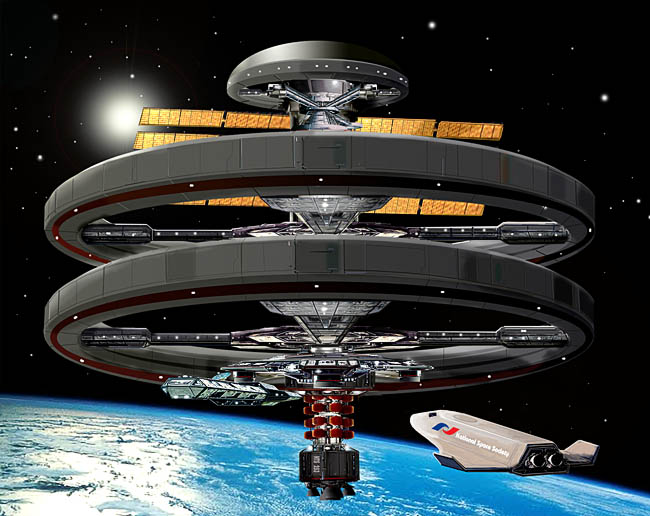Space Settlement
 |
| The Aldrin Space Settlement Space Art - National Space Society |
Playing cricket when the batsman hardly needs to hit the ball. He touches it with two of his fingers and the ball floats off. The fielder floats towards the ball to catch it. Yeah, an imaginary world. Gravity keeps us grounded here on earth. But what about living in outer space? Is it possible? When? And how?
The sole reason we are thinking about an outer space settlement is to survive and thrive. We living things want to grow and expand. We are very well aware of the threats we are going to face due to the level of climate change that has happened. Global warming might end civilization which was about to happen nearly 5 billion years later due to the red-giant stage of our sun. Another key advantage of space settlement is the ability to build new land, rather than take it from someone else. This allows a thriving, expansive civilization without war or destruction of Earth's biosphere.
Once possible, it is absolutely certain that anyone would be able to live in that new home. As of now, only trained astronauts are sent up there in the International Space Station, which is a space abode orbiting our earth. Once a proper settlement plan is laid, every commoner can start a new life up there. Zero gravity will help the handicapped get rid of their wheelchairs and live a normal floaty life. We might be able to start a bigger civilization than we have here on earth.
The earth is in the Goldilocks zone in our solar system. So, any craft, acting as our home, should be near the equator of the earth. It would be orbiting and rotating to maintain a pseudo-gravity. Arrangements must be air-tight to maintain a breathable and survivable atmosphere. It will require an independent biosphere which must be recycled continuously.
All this while, we have been talking about a craft which will serve the purpose of our new home. But why not a planet? Or a moon? Well, a spacecraft is a better option in several ways. Firstly, hunting for a planet as suitable as the earth for human survival is a tedious task. Secondly, traveling to a planet we might find light years away has its own perks. Early settlements in Earth orbit will be only hours away. This is a massive logistical advantage. For a long-term settlement, crafts will serve a much better purpose than any planet or moon. free-space settlements can rotate to provide any g level desired, although it is not true gravity. Spinning the settlement will create a force called pseudo-gravity that will feel a lot like gravity. As free-space settlement will turn, the inside of the hull will push on the inhabitants forcing them to go around. Solar power will be available nearly 24/7. These facilities might be enough to convince you that space crafts will be the best option for space settlement.
The toughest tasks to achieve in the space settlement development tent are launch, construction, and life support. Launching is expensive today because most vehicles, after a single flight, are thrown away. The keys to re-usability are technology and launch rate. There are multiple efforts in progress to develop reusable rocket technology but today's flight rate, like Space X Falcon9. A single reusable vehicle that could fly twice a week will be able to meet that demand of a high launch rate. The application of space solar power, and the right price, has the potential to launch multiple vehicles.
Although building space settlements will be exceedingly difficult, it is not impossible particularly if we start small and close to Earth. Small settlements in Low Earth Orbit directly above the equator would be much simpler, and much easier to build. Cosmic rays and solar flares create a lethal radiation environment in space but settlements in Equatorial Low Earth Orbit (ELEO) will be protected from most space radiation by the Earth and Earth's magnetic field. Solar energy is the most abundant, reliable and is commonly used to power satellites today. Massive structures will be converting sunlight into large amounts of electrical power for settlement use. Energy may also be an export item for space settlements, using microwave beams to send power to Earth.
To settle in space, we will need much better launch vehicles and avoid serious damage to the atmosphere from the thousands, perhaps millions, of launches that will be required. Transportation for millions of tons of materials from the Moon and asteroids to settlement construction sites will also be necessary once settlements expand beyond Earth's magnetic field. One possibility will be to build electronic catapults on the Moon to launch bulk materials to waiting settlements. Communication will be relatively easy. Much of the current terrestrial communications already pass through satellites. Early settlements close to Earth can plug into Earth's communication system.
It will take decades for this dream to turn into reality as Rome was not built in a day. But it will be worth the wait. The view of our earth from our new home will be breath-taking. We will get a new outlook to space. Till then we can visit the Cooper planet in the movie Interstellar whenever we want. Probably get ideas of what it would be like…living in a floating spaceship.
Author - Ayushi Mishra, Mechanical Engineering
Reference Links:
1. http://www.nss.org/settlement/journal/NSS-JOURNAL-Orbital-Space-Settlement-Radiation-Shielding.pdf
2. The Aldrin Space Settlement Space Art - National Space Society



Comments
Post a Comment